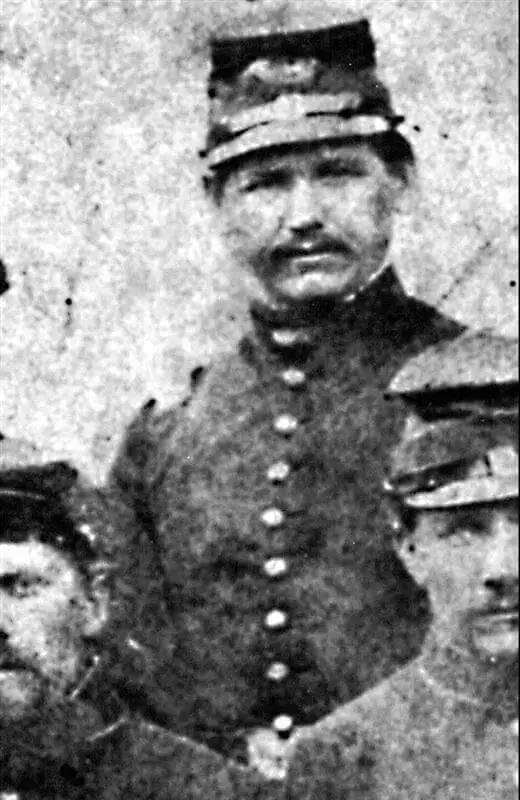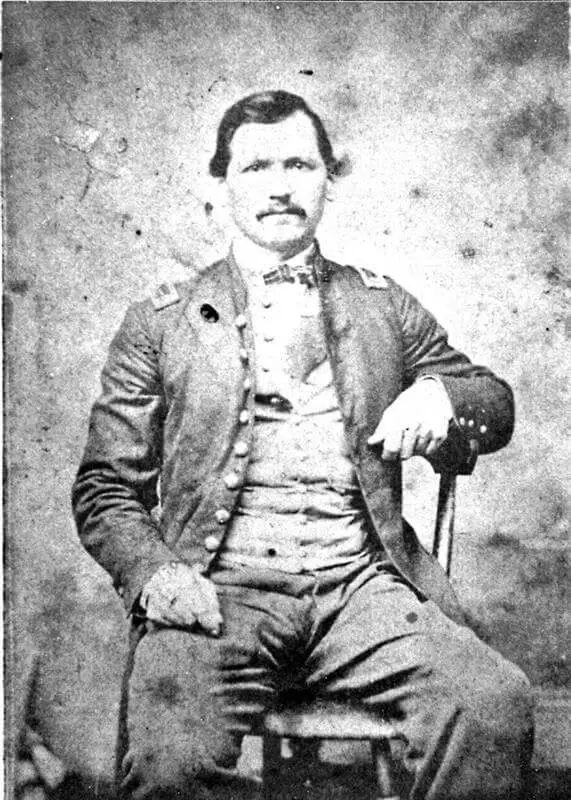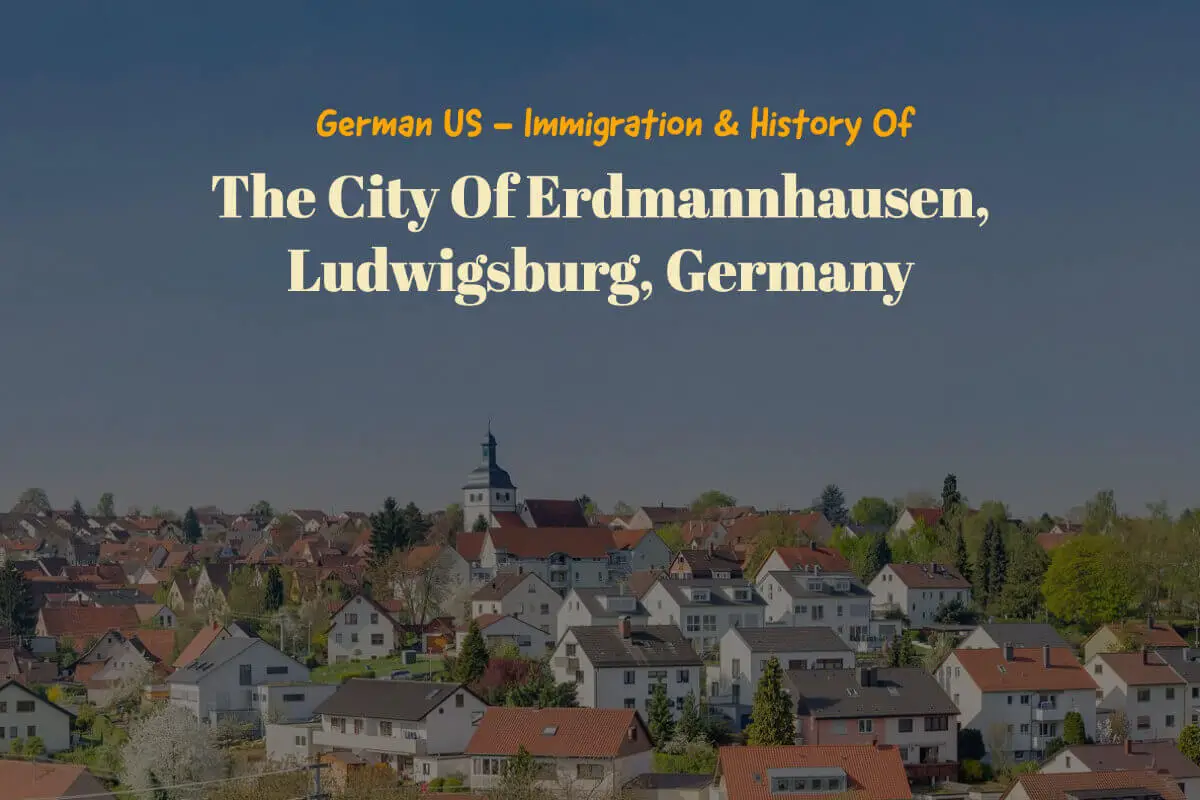Johann Gottlieb Hummel, my great great grandfather, was born in 1829 in Erdmannhausen, Ludwigsburg, German. In the 1850s, he migrated from Erdmannhausen in Germany to The United States; he arrived in the United States just in time to fight in the US Civil. War.
We cannot talk about the history of the United States without talking about the immigration of Germans to the United States. Throughout history, many Germans have immigrated to the United States and found great success. In fact, in many ways, German and American cultures are intertwined.
An example of this immigration is the great-grandfather’s leaving his hometown in Erdmannhausen, Germany, in 1859 to travel to the United States. Even though Erdmannhausen is still a small town in Germany, many Germans left this area and immigrated to the United States.
Table of Contents
- About The City Of Erdmannhausen, Ludwigsburg, Germany – Study In German Immigration
- Germany And The Exodus To The United States
- Frequently Asked Questions
- Related Questions
About The City Of Erdmannhausen, Ludwigsburg, Germany – Study In German Immigration
The City of Erdmannhausen, where my grandfather lived in Germany, is located in the district of Ludwigsburg in the German state of Baden- Wurttemberg. Today the area is located on the Neckar River and has just over 5,000 people.
So even by today’s population standard, this is not a highly populated part of Germany.
Erdmannhausen’s History And Middle Ages And Beyond
Erdmannhausen has a history that dates back to the Middle Ages. It was first mentioned as part of the country of Odenwald.
During the 16th Century, it has part of Wurttemberg and came under the rule of Duke Eberhard I. This duke founded Ludwigsburg in 1704, and the City of Erdmannhausen became an important center for trade and commerce.
1839 The Railway Comes To Erdmannhausen, Germany
The railway came to Erdmanhausen, Germany, in 1839. The railway quickly became famous for people to come to this area for a day trip from Stuttgart.
But more than that, it was also necessary for my history as my great-grandfather left Erdmannhausen by railway to travel to the United States in late 1859. The railway coming to the area undoubtedly allowed my grandfather to venture further from home and eventually end up in the United States.
The example of the railway coming to Erdmannhausen, Germany, made it easier for people to become more mobile and move around the world. Railways and new forms of transportation helped add to the immigration of people worldwide.
My grandfather is an example of this. Because the railway came to his small town, he could easily leave and eventually catch a boat to go to America. The railway showed people a world outside their own world. People could come in from other places to visit their area, and they could visit other places.
Erdmannhausen And World War II
Unfortunately, many of Erdmanhausen’s buildings were destroyed during World War II, and American troops eventually occupied the city. After Germany was officially divided in 1949, the city remained part of West Germany until German reunification in 1990.
Today Erdmanhausen is a lovely small town with some historical attractions, including castles, churches, and museums. It also has outdoor activities like hiking, fishing, and swimming.
Germany And The Exodus To The United States

My Great grandfather Johann Gottlieb Hummel and his wife Maria Strecker left Erdmannhausen in 1859 and traveled from Germany to the United States by train and boat; they took the train from Ermannhausen to Hamburg, Germany, and then a boat to the United States. Many other Germans also traveled from Germany to the United States during this time.
There were so many Germans in the United States that, at one time, the US had over 800 German-language publications.
There are many reasons why the Germans would have come to America, but one of them would have been simply because of available land and opportunity. In Germany, it was common for the oldest son to get everything.
The oldest son would get the education, he would get the land, and he would get the farm. The other children would have to find their own way. Many saw America as a land of opportunity that allowed them to earn their fortune or have some land for farming.
Here are some of the significant times Germans came to the United States:
Germans Immigration To America In The 1600s
There were a few Germans among the original settlers of the Jamestown Colony. In 1683 thirteen German Mennonite families left Germany and came to the United States; they settled outside Philadelphia in a town they called Germantown.
Germans Immigration To America In the 1700s
In the 1700s, the settling of Germans in America continued. Most came due to religious persecution and were seeking religious freedom in America.
These groups included religious groups such as the Swiss Mennonites, Baptist Dunkers, Schwenfelders, Moravians, Amish, and Waldensians. Many of these Germans belonged to the Lutheran or Reformed churches.
The most significant part of this immigration took place in locations such as Pennsylvania. And many of these immigrants came as what was known as “Redemptioners,” which means that they agreed to work in America for 4 to 7 years in exchange for free passage across the Atlantic.
Many of these immigrants were poor in their own countries, so if they were not offered this free passage, they would not have been able to come to America.
In 1783, many of the 5,000 Hessians or German soldiers hired by the British to fight in the Revolutionary War decided to remain in the United States once the war ended. In fact, by 1790, about 100,000 Germans were living in the United States and calling it their home.
An example of a German immigrant who came to the United States and was very successful was John Jacob Astor, who came to the United States in 1784 with just $25 in his pocket. By his death in 1848, he was the wealthiest man in America, with a fortune of about $20 million.
German Immigration To America In the 1800s
In the 1800s, many Germans came to the United States for religious freedom. German religious groups were purchasing land and making settlements in America in Pennsylvania, Ohio, Iowa, and Wisconsin.
The Germans introduced to the Americas the custom of decorating a Christmas tree each Christmas. Also, the Easter bunny and Easter eggs were brought to America by German immigrants.
In the 1850s, nearly 1 million Germans immigrated to America. In fact, in 1854 alone, there were 215,000 Germans who arrived in the United States.

My grandfather Johann Gottlieb Hummel was one of the many Germans who left Germany for the United States in 1869. By 1860, over 1.3 million German-born immigrants lived in the United States; many lived in what was known as the German triangle, from Cincinnati, Ohio, to Milwaukee, Wisconsin, to St Louis, Missouri.
By 1890 the immigration had continued, and there were now 2.8 million German-born immigrants living in the United States.
German Immigration To America In The 1900s
The 1900s saw two major wars on German soil – World War I and World War II. After both of these wars, we saw immigration coming from Germany.
But also, during this time, speaking German was not very popular in part due to the wars taking place in Germany, so many Germans started to assimilate fully into the United States.
In 1910 it was estimated that 2.3 million German-born immigrants were living in the United States. Many of these and their families quickly assimilated into American life and culture.
In 1933 when Adolf Hitler came into power, we saw many leading scientists, writers, musicians, and scholars leave Germany to come to the United States to live. Notable names include Albert Einstein, Bruno Walter, Arnold Schoenberg, Walter Gropius, Kurt Weil, Billy Wilder, Hans Berthe, Thomas Mann, Marlene Dietrich, and Hans Morgenthau.
In the 1940s, about 1.2 million German-born immigrants lived in the United States. This continued into the 1950s with 580,000 arrivals, and in the 1960s, 210,000 arrivals.
The City of Erdmannhausen in German is an example of a destroyed city in World War II, where many Germans left the area to move to the United States between 1945 and 1960. Erdmannhausen is now home to many Germans who have relatives who have immigrated to America.
Today, the history of the United States, Germany, and even small cities like Ermannhausen stand as a testament to the German people and their power and perseverance in facing adversity and immigration to another part of the world.
The international connections between German culture and the United States can be found throughout the United States. Today many Americans have ancestors who came from Germany.
The Hummel Family is a website all about Family History research. We focus on Swedish, German, English, Scottish, and American Genealogy. We also discussed Asia and China, as we had ancestors who spent many years in China.
You are welcome to join us and become part of our community by signing up for our FREE newsletter, The Hummel Family; sign up by clicking here.
Check out our Youtube Channel, Family History Buzz, by clicking here.
Frequently Asked Questions
Who was Johann Gottlieb Hummel?
Johann Gottlieb Hummel was your great great grandfather, born in 1829 in Erdmannhausen, Ludwigsburg, Germany.
When did Johann Gottlieb Hummel migrate from Erdmannhausen to the United States?
Johann Gottlieb Hummel migrated from Erdmannhausen, Germany to the United States in the 1850s.
Did Johann Gottlieb Hummel arrive in the United States before or after the US Civil War?
Johann Gottlieb Hummel arrived in the United States just in time to fight in the US Civil War.
Why did Johann Gottlieb Hummel decide to migrate to the United States?
The reasons behind Johann Gottlieb Hummel’s decision to migrate to the United States are not specified.
What was the significance of German immigration to the United States during that time?
German immigration to the United States during the 19th century was significant as it contributed to the cultural diversity and economic growth of the nation. Germans brought their skills, traditions, and work ethic, leaving a lasting impact on American society.
How did German and American cultures become intertwined?
German and American cultures became intertwined through the influence of German immigrants who settled in the United States. They contributed to various aspects of American life, including language, food, music, science, and education.
What was the population of Erdmannhausen, Germany during Johann Gottlieb Hummel’s time?
The specific population of Erdmannhausen, Germany during Johann Gottlieb Hummel’s time is not provided, but it is mentioned that Erdmannhausen was a small town in Germany.
Did Johann Gottlieb Hummel’s migration from Erdmannhausen to the United States impact the population of Germans in that area?
It is possible that Johann Gottlieb Hummel’s migration from Erdmannhausen to the United States contributed to a decrease in the population of Germans in that area, as many Germans left Erdmannhausen and immigrated to the United States during that time.
Related Questions
What Are The Swedish Mantal Tax Records?
The Swedish Mantal tax system was the tax system prevalent in Sweden for over 300 years. The Mantal tax was a tax placed upon Swedish households and people. The Mantal tax system was organized and structured.
You can learn more by reading our blog What Are The Swedish Mantal Tax Records? History & Genealogy Research Tips by clicking here.
What Is The Purpose of Genealogy?
The purpose of genealogy is to study family, family history, and the tracing of our lineage or our ancestors. The purpose of genealogy goes far beyond the dates, names, and places of our ancestors. This is because as you do your genealogy, you begin to learn more about your family and yourself. Genealogy helps to unite and link families together as you discover things about your family that you did not know.
You can learn more about Genealogy by reading our blog What Is The Purpose of Genealogy? by clicking here.

